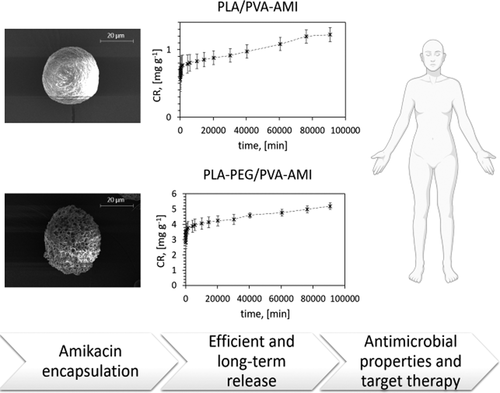当前位置:
X-MOL 学术
›
Mol. Pharmaceutics
›
论文详情
Our official English website, www.x-mol.net, welcomes your
feedback! (Note: you will need to create a separate account there.)
Encapsulation of Amikacin into Microparticles Based on Low-Molecular-Weight Poly(lactic acid) and Poly(lactic acid-co-polyethylene glycol)
Molecular Pharmaceutics ( IF 4.5 ) Pub Date : 2021-07-01 , DOI: 10.1021/acs.molpharmaceut.1c00193 Marta Glinka 1 , Katerina Filatova 2 , Justyna Kucińska-Lipka 3 , Eva Domincova Bergerova 2 , Andrzej Wasik 1 , Vladimir Sedlařík 2
Molecular Pharmaceutics ( IF 4.5 ) Pub Date : 2021-07-01 , DOI: 10.1021/acs.molpharmaceut.1c00193 Marta Glinka 1 , Katerina Filatova 2 , Justyna Kucińska-Lipka 3 , Eva Domincova Bergerova 2 , Andrzej Wasik 1 , Vladimir Sedlařík 2
Affiliation

|
The aim of this study was to fabricate novel microparticles (MPs) for efficient and long-term delivery of amikacin (AMI). The emulsification method proposed for encapsulating AMI employed low-molecular-weight poly(lactic acid) (PLA) and poly(lactic acid-co-polyethylene glycol) (PLA–PEG), both supplemented with poly(vinyl alcohol) (PVA). The diameters of the particles obtained were determined as less than 30 μm. Based on an in-vitro release study, it was proven that the MPs (both PLA/PVA- and PLA–PEG/PVA-based) demonstrated long-term AMI release (2 months), the kinetics of which adhered to the Korsmeyer–Peppas model. The loading efficiencies of AMI in the study were determined at the followings levels: 36.5 ± 1.5 μg/mg for the PLA-based MPs and 106 ± 32 μg/mg for the PLA–PEG-based MPs. These values were relatively high and draw parallels with studies published on the encapsulation of aminoglycosides. The MPs provided antimicrobial action against the Staphylococcus aureus, Escherichia coli, Pseudomonas aeruginosa, and Klebsiella pneumoniae bacterial strains. The materials were also comprehensively characterized by the following methods: differential scanning calorimetry; gel permeation chromatography; scanning electron microscopy; Fourier transform infrared spectroscopy–attenuated total reflectance; energy-dispersive X-ray fluorescence; and Brunauer–Emmett–Teller surface area analysis. The findings of this study contribute toward discerning new means for conducting targeted therapy with polar, broad spectrum antibiotics.
中文翻译:

基于低分子量聚乳酸和聚乳酸-聚乙二醇的微粒封装阿米卡星
本研究的目的是制造新型微粒(MP),以高效、长期地输送阿米卡星(AMI)。提出的用于封装 AMI 的乳化方法采用低分子量聚乳酸 (PLA) 和聚乳酸-聚乙二醇 (PLA-PEG),两者均辅以聚乙烯醇 (PVA)。所得颗粒的直径测定为小于30μm。基于体外释放研究,证明 MP(基于 PLA/PVA 和基于 PLA-PEG/PVA)表现出长期 AMI 释放(2 个月),其动力学遵循 Korsmeyer-佩帕斯模型。研究中 AMI 的负载效率确定为以下水平:基于 PLA 的 MP 为 36.5 ± 1.5 μg/mg,基于 PLA-PEG 的 MP 为 106 ± 32 μg/mg。这些值相对较高,与发表的氨基糖苷类胶囊化研究相似。 MP 对金黄色葡萄球菌、大肠杆菌、铜绿假单胞菌和肺炎克雷伯菌菌株具有抗菌作用。还通过差示扫描量热法对材料进行了综合表征;凝胶渗透色谱法;扫描电子显微镜;傅里叶变换红外光谱——衰减全反射;能量色散X射线荧光;和 Brunauer-Emmett-Teller 表面积分析。这项研究的结果有助于寻找使用极性广谱抗生素进行靶向治疗的新方法。
更新日期:2021-08-03
中文翻译:

基于低分子量聚乳酸和聚乳酸-聚乙二醇的微粒封装阿米卡星
本研究的目的是制造新型微粒(MP),以高效、长期地输送阿米卡星(AMI)。提出的用于封装 AMI 的乳化方法采用低分子量聚乳酸 (PLA) 和聚乳酸-聚乙二醇 (PLA-PEG),两者均辅以聚乙烯醇 (PVA)。所得颗粒的直径测定为小于30μm。基于体外释放研究,证明 MP(基于 PLA/PVA 和基于 PLA-PEG/PVA)表现出长期 AMI 释放(2 个月),其动力学遵循 Korsmeyer-佩帕斯模型。研究中 AMI 的负载效率确定为以下水平:基于 PLA 的 MP 为 36.5 ± 1.5 μg/mg,基于 PLA-PEG 的 MP 为 106 ± 32 μg/mg。这些值相对较高,与发表的氨基糖苷类胶囊化研究相似。 MP 对金黄色葡萄球菌、大肠杆菌、铜绿假单胞菌和肺炎克雷伯菌菌株具有抗菌作用。还通过差示扫描量热法对材料进行了综合表征;凝胶渗透色谱法;扫描电子显微镜;傅里叶变换红外光谱——衰减全反射;能量色散X射线荧光;和 Brunauer-Emmett-Teller 表面积分析。这项研究的结果有助于寻找使用极性广谱抗生素进行靶向治疗的新方法。











































 京公网安备 11010802027423号
京公网安备 11010802027423号